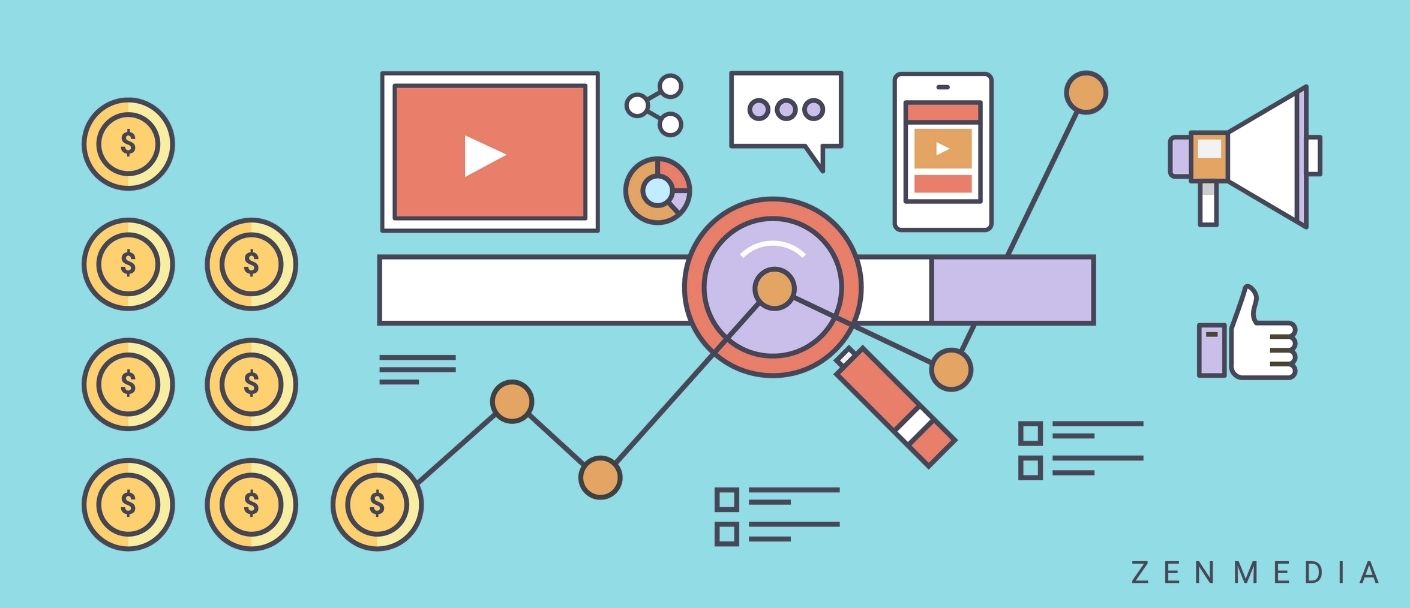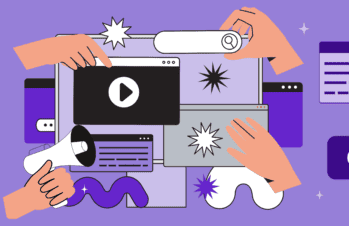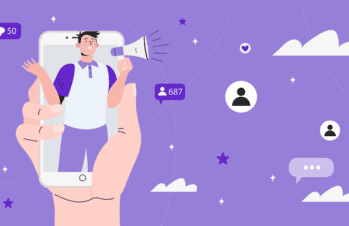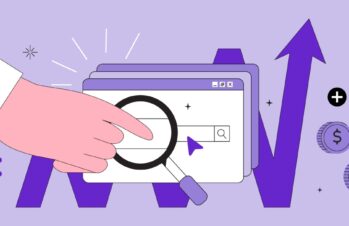Wouldn’t it be great if you could rely on just putting out great content and letting customers find you without spending a dime on paid ads?
Yes. It totally would. But that’s not the reality we’re living in.
The thing is, no matter how great your content and services may be, there’s simply too much content online. You can’t rely on attracting your customers’ attention when you’re competing with millions of other pieces of content and thousands of other brands at any given moment.
This is where B2B paid advertising comes in.
Let’s take a closer look at how paid ads can benefit your B2B company.
What is B2B paid advertising?
B2B paid advertising is a form of B2B marketing where businesses use paid ads to attract potential customers. The main goal of B2B paid advertising is to get potential buyers to engage with your business and reach out to prospects who are interested in buying from your business.
B2B paid advertising includes display advertising such as banner ads, popups, and interstitials, as well as video advertisements. The main difference between B2C and B2B paid advertising is that B2B paid advertising typically want to reach specific audiences rather than general audiences.
What can B2B paid advertising do for your brand?
Here’s a brief rundown of some of the benefits of B2B paid advertising:
- Ensure your content reaches the greatest number of targeted people possible.
- Increase conversions.
- Increase engagements.
- Increase awareness.
- Boost sales.
- Boost lead generation.
When it’s paired with other marketing tactics like social media, content, and B2B PR, B2B paid advertising can give your brand the boost it needs to get to the forefront of your industry.
How do you measure the success of B2B paid advertising?
B2B paid advertising has become one of the most effective ways for businesses to reach potential customers. The key to measuring the effectiveness of any campaign is to track conversions. Conversion tracking allows you to determine which campaigns are working best, and what changes need to be made to future campaigns.
You should also be tracking the ROI of your B2B paid advertising campaign. If you want to know what works for your business, then you need to find out which B2B paid ad campaigns generate the highest return on investment. This means finding out which ones convert into sales.
Why does your B2B brand need paid advertising?
As mentioned above, even if your brand is a household name like Xerox or IBM, it can’t compete with the amount of other industry content based on organic reach alone. It just won’t happen.
Remember, online you’re not only competing with other businesses in your niche—you’re up against businesses in any and every industry. You’re competing for your potential customer’s attention.
In fact, the next time you’re feeling unsure about committing budget dollars to B2B paid advertising, here’s something to consider.
Those household names spend massive amounts on online advertising. Alphabet, Google’s parent company, spent $774 million in 2020. Microsoft spent $160 million in the same year.
That’s a big part of how they stay at the top of their industries and top-of-mind for their customers.
One caveat: Obviously, great B2B paid advertising can’t fix a bad product or service.
Now that that’s out of the way, let’s take a look at B2B paid advertising’s benefits more closely.
B2B paid advertising lets you increase your exposure on SERPs
78% of B2B buyers start the purchasing process with a Google search.
This is why those Google search results (or SERPs, search engine results pages) matter so much. Your brand needs to show up near the top, ideally within the first five sites, when your prospects search a relevant keyword.
You can continue to climb through the search rankings with B2B SEO strategies, but investing in a paid advertising strategy ensures that your prospects see your brand even if you haven’t broken through to that first page of results yet. When people search a keyword that you’ve targeted with your ad, that ad will pop up on the sidebar and, hopefully, get you more site traffic, demo sign-ups, newsletter sign-ups, purchases, etc.
B2B paid ads help you achieve concrete conversion goals
One key principle with B2B paid advertising is to tightly focus each ad (or ad set) on one single conversion action that you want customers to take.
For example:
- Downloading an ebook
- Visiting your new product page
- Signing up for a demo
- Following you on social
Ads work best when they lead users exactly where you want them to go. So, if the ad copy reads, “Download our latest report,” the user who clicks on it should be taken directly to a dedicated landing page where they can provide their email address and download the report—not to your full site (although you should include a link to your full site for those who want to explore more).
By choosing specific actions you want people to take, you can create groups of ads that help you reach each of those goals.
Here’s an example.
Let’s say we want people to sign up for a demo of our new product.
The first step would be to create a landing page for the demo sign-up. The landing page is where we’ll direct users when they click on our ad.
Pro tip: Set up an A/B test using two versions of the same landing page. Send users to one or the other with your ad. Then, you can compare the conversion rates for each landing page to see which one performed better, and use the results to inform future design choices.
Once your landing page is designed and live, it’s time to focus on your paid advertising strategy. We’re going to start by laying out the goal and creating three different ads that will help us reach it.
Related post: 4 Critical Tips for Getting the Most Out of Paid Social Ads
Goal: Get demo signups.
The first thing to do is identify the keywords that you’re going to target. Use a tool like SEMRush or Google Keywords to help with this—you’re looking for keywords that are highly relevant, yet also mid-range in volume.
Why?
Because the higher the volume for a keyword (like “B2B SAAS demos”), the more it will cost you per click. Additionally, higher-volume keywords can become so general that they don’t move the needle or so expensive that it doesn’t make sense to spend the budget, considering how intense your competition for those clicks will be.
So, instead of choosing “B2B SAAS demos,” you could choose “best B2B SAAS demo for mid-size companies,” or “affordable B2B SAAS demo,” or some other variation that fits your product and matches what your audience is searching for.
Related post: The Ultimate Guide to Creating a Search Engine Marketing Strategy
Ideally, you’ll create a few different B2B paid ads for one goal, both so that you can see which digital campaign works best and so you can maximize your reach.
Once you have those ads running, whether simultaneously or one at a time, you’ll be able to see which is performing best.
B2B paid advertising strategies for 2023
B2B marketing has changed drastically in the past few years, and it’s still evolving. What strategies should you be using to reap the benefits of paid media in 2023?
With more companies relying on digital solutions to reach B2B buyers, B2B paid advertising is an important tool for all sizes of business. Traditional tactics, like print or radio ads, are no longer effective, as consumers have become conditioned to ignore these. Today’s marketers need to think more strategically about B2B paid advertising strategies in order to be successful.
As technology continues to evolve rapidly and changes occur within the marketplace, new strategies will emerge to help businesses capitalize on their target audience through paid B2B advertising campaigns. To stay ahead of the competition and maximize returns in 2023, here are the top two B2B paid advertising strategies that marketers should be aware of.
1. Leverage first-party data for the most refined and accurate retargeting audience
First-party data is extremely valuable for running effective ad campaigns because it offers insights directly from a brand’s customers. This data includes behavioral patterns and other types of user interactions with the brand, such as website visits and purchases. These insights can be used to create personalized marketing strategies that will help target more relevant audiences, increase campaign effectiveness and ROI, optimize ad creative and messaging, and improve customer satisfaction.
2. Utilize multiple channels to earn more exposure and keep your brand in front of your target audience
Running B2B paid ads on multiple different platforms allows you to reach a wide variety of audiences and ensure your message is seen by the people who need it. This also allows you to target customers in specific locations or customer segments, as each platform has its own targeting features. Additionally, running ads on multiple different platforms helps you build an effective multi-channel marketing strategy and track which channels are delivering the most conversions, giving you valuable data for optimization.
The importance of paid advertising for B2B brands
It’s easy to see how important advertising is for B2C, especially since customers can sometimes complete the entire purchasing journey after seeing just a couple ads on social.
That’s not the case for B2B, but ads are still just as critical.
For one thing, they can shorten the sales cycle. Research shows that it takes prospects at least 18 interactions with a brand before they take any action to buy. That number is likely higher, given that so many interactions are now happening on dark social or elsewhere where they can’t be known or tracked.
If three or four of those interactions are through a prospect seeing your B2B paid ads, you’ve already shortened your sales cycle.
If you’re trying to increase engagement on social, B2B paid advertising can be a great way to funnel more prospects and customers to your social channels. And, of course, ads that are both highly targeted and closely focused on a single action can go a long way toward boosting your qualified lead generation.
Related post: B2B Marketing Budgets: Benefits of Branding over Lead Gen Campaigns
Ready to get started? Let our SEM team help.







